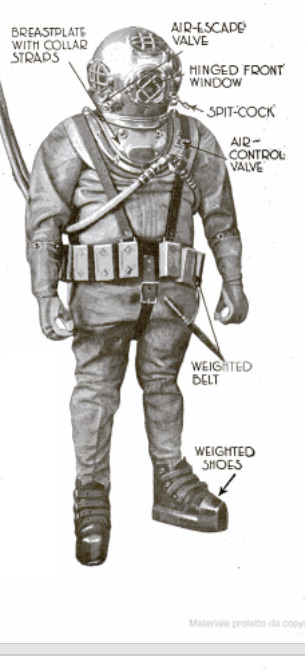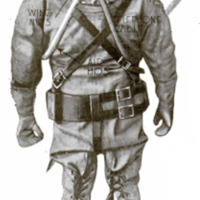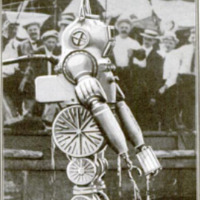The diving suits used by the British and the U. S. Navies
Contenuto
-
Titolo
-
The diving suits used by the British and the U. S. Navies
-
Article Title and/or Image Caption
-
Title: In the Grip of the Deep
-
Subtitle: How wonderful diving suits enable men to face terrific under-water pressure
-
extracted text
-
FULLY eight thousand ships lie at
the bottom of the ocean—ships
of all countries, which were tor-
pedoed, mined, bombed, scuttled, or
sunk by the shell-fire of German sub-
marines. The world needs shipping,
despite the wonderful efforts that were
put forth in the United States and in
Great Britain to keep pace with the
sinkings of German submarines.
Let us admit at the outset that most
of the ships that were sent to the bot-
tom cannot be recovered by the
methods that have thus far been de-
veloped. In the open sea it is hardly
practicable to recover a ship that lies
at a depth greater than one hundred
feet. Only in a sheltered bay are
greater depths reached.
How are they reached? By actually
sending a man down beneath the
waves—a man who dons a divers
dress and adapts himself to conditions
that nature never intended him to
meet.
A Remarkable Invention
In many ways the divers dress is
one of the most remarkable of inven-
tions. Reduced to its essentials, the
dress consists of an incompressible
metal helmet and a compressible
fabric garment for the body and legs.
Air is pumped into the helmet, and
thence into the upper part of the dress,
through an air-hose connected either
with a pump or a tank of compressed
air in a surface vessel. It escapes
through an automatic valve in the
helmet which the diver can regulate.
Blown up with air, the dress contain-
ing the diver becomes a veritable bub-
ble. To sink it and keep the man in-
side in an upright position,
it must be weighted. Hence
shoes are donned, each of
which contains sixteen
pounds of lead. Around the
body eighty pounds
of lead are distrib-
uted. Exclusive of
the diver, the dress
weighs one hundred
and seventy - five
pounds. In order to
prevent the diver
from capsizing and
coming up feet first, even though
he may be thus weighted, the
legs of the dress are laced up
the back, a procedure recom-
mended by the British Admir-
alty and adopted by the United
States Navy.
Everything depends on the
nice regulation of air-pressure.
If the pressure is too little the
diver feels the water trying to
squeeze him; if it is too great his
dress becomes too buoyant. So he ad-
justs the valve in his helmet until the
water-pressure without is a little more
than equalized by the air-pressure
within.
The automatic escape-valve also
provides an outlet for the poisonous
carbon dioxide exhaled. Bubbles of
air constantly stream out of the valve.
Since it is automatic, the valve is
forced open to let the surface air
escape when the pressure within be-
comes too great. Moreover, it is so
constructed that water cannot enter.
The diver must adjust the valve to
suit his convenience.
How He Goes Down
The diver descends by a ‘“‘shot-
rope’—a rope sunk by a heavy
weight or a shot. When he reaches
the bottom he takes with him a
“distance-line” attached to this
weight. The distance-line helps
him to find the shot-rope again; for
it is dark far below the surface—
darker than the darkest night. He
must feel his way. A little electric
lamp held in the hand illuminates
an object a few inches away. That
is all the light that he has.
He reaches the bottom. One
pull on the breast-rope tells the
attendant above. The diver clears
away the distance-line, coiling it in
the left hand, and slips the left
wrist through a loop at the end,
s0 that he will not drop the line in
a moment of forgetfulness. The
bottom is often muddy. Therefore
he does not flounder about and stir
up the silt; he knows that a cloud
of mud would prevent him from
seeing anything.
For the same reason, the diver
keeps to the lee side of his work
if there is any current. He
spreads himself over the bottom,
particularly if it is soft. He does
not try to stand. He crouches
close to the ground, so as to offer
as little surface as possible to the
action of the tide.
Safer than It Used to Be
Thanks to the researches conducted
by the British Admiralty, diving is a
safer profession than it used to be.
A man no longer risks his life when he
has descended to the great depth of
three hundred feet. Time was when
a diver was hoisted to the surface after
having performed his work below,
sometimes at a depth of more than one
hundred feet, without any
regard to the interval that
should be allowed.
When a man is sub-
jected to great air-pres-
sure, his blood and his
tissues absorb nitrogen.
This nitrogen is not chem-
jeally combined with the
blood, as in the case of the
oxygen that we breathe,
but is released again in
the form of bubbles when
normal pressureis restored.
In other words, a man who
works in a diver’s suit at
a depth of one hundred or
two hundred feet is like
a siphon of seltzer water.
So long as he remains at
that depth or is subjected to the
equivalent air-pressure, his blood
is as quiet as the water in the
siphon. But if the pressure be sud-
denly removed the nitrogen bubbles
off from his blood exactly as a
gas bubbles up out of the water in
the siphon when the spring valve
handle is pressed down and a glass
of water is drawn. This bubbling
up of the nitrogen is extremely
painful. What is more, it may
cost a man his life. He suffers
from what is known as ‘caisson
disease” or the “bends.”
Working Under Water
The British Admiralty’s inves-
tigating committee, consisting of
Dr. Haldane, Dr. Boycott, and
Lieutenant Damant, discovered
that if a diver is brought up grad-
ually from a great depth nitrogen
is able to boil from the blood and
tissues so slowly that no distress is
experienced. A table was compiled
which is now consulted whenever
it is necessary to send men to the
bottom of the ocean. That table
tells at once at what rate a man
should be hauled up.
The deeper a man goes, the less
work is he able to perform. When
the United States Navy divers de-
‘scencer to a depth of ‘three huncred.
feet, for instance, they could do little
‘more than walk about for a few min-
utes in order to locate the wreck of the
F4. Now, a diver is supposed to
work under water. Usually he locates
a wreck and patches up the leaks.
Since his efficiency is limited by his
depth, it is clear that the present form
of diver's dress is not all that can be
desired.
Why is it not possible to construct
a suit of steel something so strong
that it will of itself resist the pressure
of water at even six hundred feet?
The. diver could then breathe air at
ordinary pressure. Inventors have
contrived new suits—diving armor—
that are amazingly ingenious. And
yet ship salvors and men who work
at the bottom of the ocean will have
none of them.
The diver cannot directly use his
hands when he is incased in his suit of
armor. Indeed, it would be squeezed
into a shapeless mass if he could
protrude it at a depth of several hun-
dred feet. Hence, ingenious artificial
hands have been invented which are
worked from the inside of the suit.
Sometimes these artificial hands are
mere claws, sometimes highly inge-
nious and complicated mechanisms.
Perhaps some form of diving armor
will be invented to meet the salvage
engineer's requirements. Certainly the
rewards to be earned are rich; for lit-
erally billions of dollars’ worth of
ships and cargos lie at the bottom
of the ocean.
-
Autore secondario
-
Waldemar Kaempffert (Article writer)
-
Lingua
-
eng
-
Data di rilascio
-
1919-06
-
pagine
-
42-43
-
Diritti
-
Public domain (Google digitized)
-
Archived by
-
Davide Donà
-
Marco Bortolami (editor)







